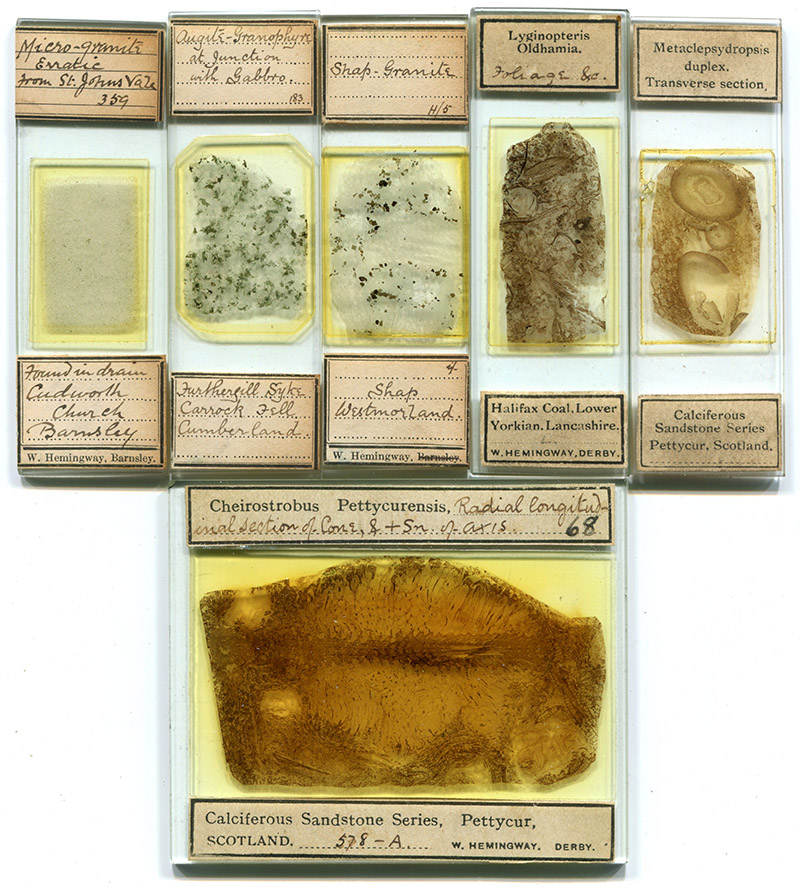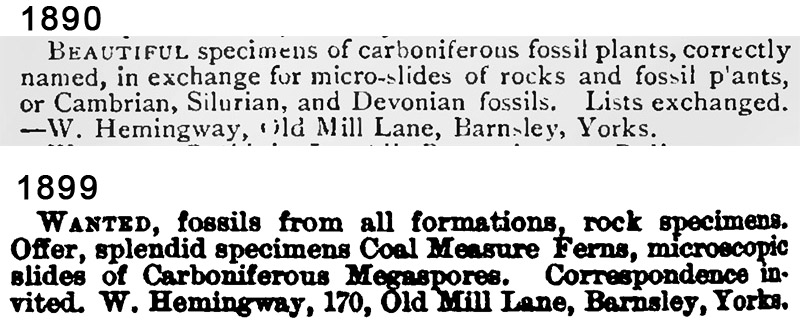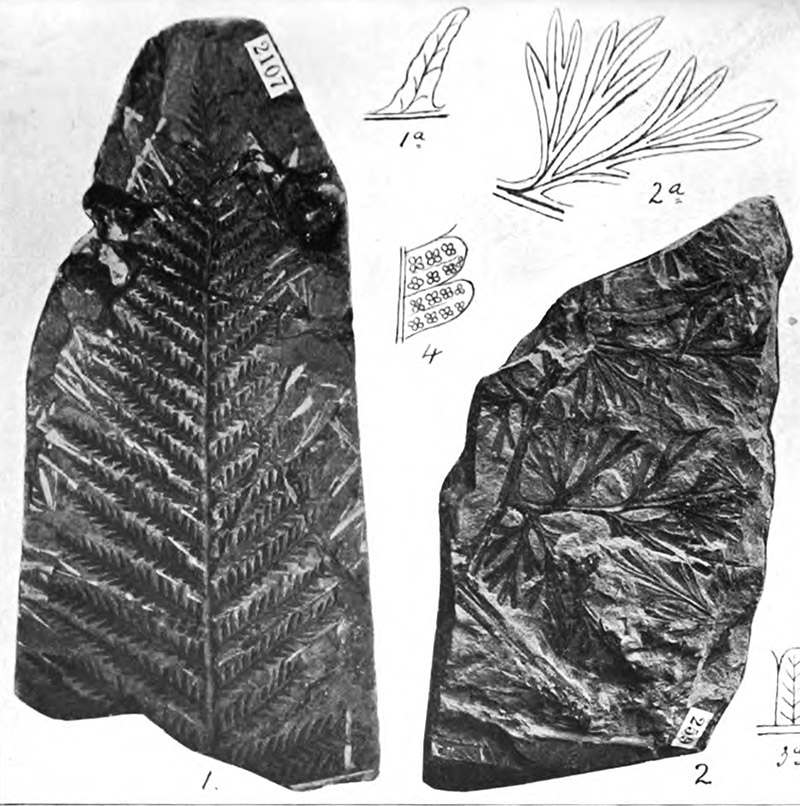Walter Hemingway, 1859 - 1947
by Brian Stevenson
last updated July, 2016
This working-class Englishman built a well-regarded paleobotany and geology business from his interests in coal fossils and local geography. Hemingway lived most of his early life in Barnsley, Yorkshire, working both in the coal mines and paper mills. He lived in that city until the mid-1910s, when he moved to Derby, Derbyshire. Addresses on the labels of Hemingway’s microscope slides thereby date their preparation (Figure 1).

Figure 1.
Microscope slides of thin-sectioned minerals and coal fossils. Top row, left to right: Mineral labeled “W. Hemingway, Barnsley”; Mineral with the same handwriting but unsigned labels, possibly retailed through another dealer; Mineral with the Barnsley address crossed out, probably dating from the mid-1910s when Hemingway moved from Barnsley to Derby; Coal fossil with machine-printed labels bearing “W. Hemingway, Derby”; Coal fossil with unsigned, machine-printed labels. Lower: 3 x 2 ½ inch slide of coal fossil, with machine-printed label from Derby.

Figure 2.
Two exchange offers from “Science-Gossip”.
Walter Hemingway was born on August 14, 1859, in Barnsley. He was the second of at least nine children born to John and Elizabeth Hemingway. At the time of Walter’s birth, his father worked as a “warehouse man”, but was recorded in the 1861 census and afterward as being a coal miner. By 1881, father John also operated a grocery shop, in addition to mining.
The 1881 census recorded 21 year-old Walter as being an unemployed “paper maker”. Barnsley had at least one large paper-producing mill at that time. Walter’s younger brothers worked at the paper mill in later years.
Walter showed serious interest in nature by his early twenties. An August, 1882, report from the Barnsley Naturalists’ Society noted that Hemingway was involved with producing a list of local plants. That report also included descriptions of investigations on local geology and fossils, indicating that Hemingway was well-acquainted with experts in those fields. In 1884, Hemingway published two papers in the Quarterly Transactions of the Barnsley Naturalists’ Society: “Fossil flora of the Barnsley District” (described as “Notes on Lepidostrobus, Sporites, Trigonocarpum, Cardiocarpum, Lepidophyllum, Zeugopteris, Cyclopteris, and an enumeration of the ferns”), and “Geology [near Barnsley]” (described as “Notes on various coal-measure fossils observed, and of observations made at Mr. S. Seal’s quarries at Darfield”).
Hemingway also befriended experts in geology and paleontology from beyond his home area. W. Lower Carter (1855-1918) quoted from “Mr. Walter Hemingway's (Barnsley) letter of April 6th, 1885, to Professor Green” (Alexander Henry Green, 1832-1896): “Referring to the excavation at Old Mill Gasworks, I looked over the material at the 'tip' after Thursday morning's rain, and found the gravel which had come from between the stony clay and the fine blue clay at bottom of section to contain a fair quantity of foreign rocks, chiefly dark greenish fine-grained trap”.
Writing on glaciation in the Don and Dearne River Valleys, Carter stated that “the author has taken opportunities of going over portions of the ground with experienced local workers, including Mr. Walter Hemingway, of Barnsley”. He further emphasized that Hemingway was not a mere collector, explaining that “Mr. Walter Hemingway, of Barnsley, has recently traced two tongues of this drift into the valley of the Dearne, and has recorded a section of contorted shale with pockets of erratics from the excavation for the Barnsley gasometer”.
Another national expert with whom Hemingway worked was paleobotanist Robert Kidston (1852-1924). Kidston obtained a considerable number of specimens from Hemingway, and Hemingway produced thin-sectioned slides for Kidston (Figure 3). His contributions were acknowledged in many of Kidston’s writings.
Hemingway donated a large number of specimens, with accompanying notes, to the Yorkshire Boulder Committee, in 1894. This was acknowledged in The Naturalist as “During the year special attention has been given by the Committee to the glacial geology of the hilly country around Barnsley, and they cordially recognise the valuable services of Mr. Hemingway, Old Mill Lane, Barnsley, but for whose labours, extending over several years, many evidences of ice-action in this district would have been irrecoverably lost. The extensive series of personally-collected specimens submitted by him for identification, along with the perforated map accompanying his report, has materially aided the investigation, and lightened the work attempted by this Committee”.
Walter married Martha Ann Sellers in late 1892. The couple had seven children over the next 14 years. While Walter was working as a “coal miner” at the time of the 1891 census, he changed occupations during the next several years, reporting to be a “photographer” in 1901.
The 1911 census records Walter as being a “microscope slide maker”, indicating that this had become his main occupation. He relocated to Derby, Derbyshire at some point before 1918, when an article by Hemingway was published in The Naturalist, bearing the address of 1 Seale Street, Chester Green, Derby.
Hemingway continued to sell slides through the following decades. In 1927, the British Geological Survey purchased “73 microscope slides of fossil plants … from Mr. W. Hemingway of Derby”. In 1934, the B.G.S. reported that “three microscope sections of Cheirostrobus pettycurensis and two of Lepidodendron wünschianum have been purchased from Mr. W. Hemingway, of Derby”.
Walter Hemingway died in Derby in September, 1947, at the age of 87.

Figure 3.
Specimens of plant fossils in coal, provided by (left) Walter Hemingway and (right) coal miner and slide-maker John Simm, which were described by Robert Kidston in “Proceedings of the Yorkshire Geological Society”, 1902. The original figure legend reads, “Fig. 1. Ductylotheca plumom Artis. sp. Monckton Main Colliery, near Barnsley. Middle Coal Measures. Natural size. Collected by Mr. W. Hemingway; Fig. 1a. Pinnule enlarged four times; Fig. 2. Spheiurpteris furcata Brongt. Cramlington, Northumberland. Lower Coal Measures. Natural size. Collected by Mr. J. Sim; Fig. 2a. Pinnule enlarged to show nervation.
Resources
Bracegirdle, Brian (1998) Microscopical Mounts and Mounters, Quekett Microscopical Club, London, pages 51 and 146, Plate 21-D
British Geological Survey (accessed July, 2016) Alexander Henry Green, http://www.bgs.ac.uk/discoveringGeology/geologyOfBritain/archives/ahgreen/home.html
Carter, W. Lower (1904) The glaciation of the Don and Dearne Valleys, Proceedings of the Yorkshire Geological Society, Vol. 15, pages 411-436
Carter, W. Lower (1904) The glaciation of the Don and Dearne Valleys, Geological Magazine, Decade 5, Vol. 15, pages 546-551
England birth, marriage, census, and death records, accessed through ancestry.com
Gerhard, John (1904) Notes on fossils found above the Bradford Four Feet coal at Bradford Colliery, Manchester, “The shells have been identified by Dr. Wheelton Hind, the fish remains by Mr. John Ward and Mr. Herbert Bolton, and the plants by Mr. Walter Hemingway”, Transactions of the Manchester Geological Society, Vol. 28, pages 555-562
Hardwicke’s Science-Gossip (1890) Exchange offer from Walter Hemingway, Vol. 26, page 72
Hemingway, Walter (1918) The late G. Knott, The Naturalist, page 271
Howell, Alan C. (2005) James Lomax (1857-1934): palaeobotanical catalyst or hindrance?, in History of Palaeobotany: Selected Essays, edited by A.J. Bowden, C.V. Burek, and R. Wilding, pages 137-152
Kidston, Robert (1888) On the fructification of two coal-measure ferns, Proceedings of the Royal Physical Society of Edinburgh, Vol. 9, pages 510-516
Kidston, Robert (1890) The Yorkshire Carboniferous Flora, Yorkshire Naturalists’ Union, Leeds
Kidston, Robert (1902) The flora of the Carboniferous period, Proceedings of the Yorkshire Geological Society, Vol. 14, pages 189-230
Liston, J.J., and H.L. Sanders (2005) The “other” Glasgow Boys: the rise and fall of a school of palaeobotany, in History of Palaeobotany: Selected Essays, edited by A.J. Bowden, C.V. Burek, and R. Wilding, pages 197-228
The Naturalist (1882) Barnsley Naturalists’ Society, Vol. 8, page 28
The Naturalist (1884) Bibliography of 1884, Vol. 10, page 397
The Naturalist's Directory (1904) “Hemingway, W., 170, Old Mill Lane, Barnsley (Palaeontology, Petrology, special study Palaeobotany; exchange desired)”
Proceedings of the Yorkshire Geological Society (1922) In Memoriam: The Rev. W. Lower Carter, M.A., F.G.S., 1855-1918, Vol. 19, pages 423-424
Science-Gossip (1899) Exchange offer from Walter Hemingway, New series, Vol. 5, page 380
Summary of Progress of the Geological Survey of Great Britain and the Museum of Practical Geology (1927) page 40
Summary of Progress of the Geological Survey of Great Britain and the Museum of Practical Geology (1934) page 34
Tate, Thomas (1894) The Yorkshire Boulder Committee and its eighth year’s work, The Naturalist, pages 297-299
Thompson, Christine A., and Ian P. Wilkinson (2009) Robert Kidston (1852-1924): A biography of a Scottish paleobotanist, NERC Open Research Archive, http://nora.nerc.ac.uk/8399/1/RKidston.pdf


